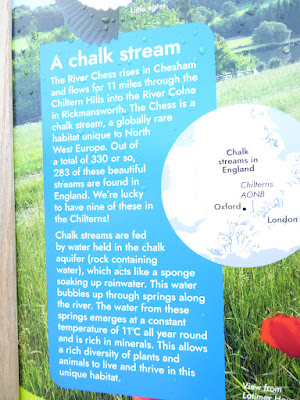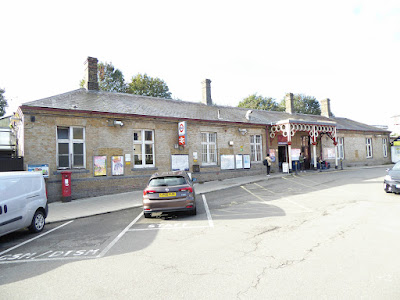At the end of platform 1 is a disused signal box which ceased service in the 1960s. It was proposed by the local residents association that the Grade II listed signal box be turned into a museum. Due to various costs and legal fees this no longer seems to be a viable proposition.

The golf club. The sign told me that this is a public golf course so it's not just for members.
I continued on and beside this row of houses was a narrow lane with houses dated around the 1870s.
This lane led me back under the railway and onto a wide tree lined road with a number of small shops.
Sadly, at least three of them were empty. A sign of the times since Covid.
There was a lovely bookshop and a couple of cafes which I will probably visit on my way back.
I walked out of the village and up Shire Lane and came across an unusual building for a catholic church. This was one of the houses built to encourage city workers to move out into Metroland. First constructed in 1898, it was then extended for the artist Alfred Elias and his wife in 1904. The extension was carried out by a well known British architect, Charles Voysey. The main parish church was a long way from here and initially mass was held in a parishioner's home. Money was raised and a house bought which was converted into this church.
Just an ordinary post box you might think but on closer inspection this is a first for me.

Walking away from the village was not so easy as there were no pavements and a fair bit of traffic. However, the weather was pleasant and I was now out in the country with views of fields.
The name relates to the chartist movement that demanded, amongst other things, the vote for working men at a time when only property owners could take part in parliamentary elections. In the 1840s a short lived chartist community was set up in this area. I discovered this when I met the volunteers at the Rickmansworth Museum that I mentioned in my previous post. It is the main reason that I have left the village of Chorleywood, as I am looking for any evidence of that community in a small area called Heronsgate. This pub was once the beer house attached to the community.
The village of Heronsgate retains much of the original layout with its narrow lanes named after northern towns such as Bradford, Halifax, Nottingham etc. The village now has Conservation area status due to its historic and architectural interest.
A lane leading to Heronsgate was signed off to the right just a short distance from the pub. It was originally known as O'Connorville named after a radical MP, Feargus O'Connor. He founded the Chartist Land Company in 1845 which soon had 70,000 shareholders and capital of £4000. He purchased land here and divided it into 36 lots of between two and five acres where families from urban slums could raise livestock, grow fruit and veg and become self sufficient. This was the first time houses had been built for the working classes other than by an employer to accommodate his workers. The scheme was widely advertised and attracted many applicants mostly from the industrial north. Applicants were chosen by a ballot. The rent would be 5% of the total cost of the estate and each settler would receive £87 per acre for tools, seed etc. By buying their own properties this would give the settlers the right to vote as well as the means to support themselves and their families by farming the land attached to their properties. The idea was excellent but the reality was not. Urban workers had no idea had to farm the land and they did not really have enough land to live off. Many found it too hard and couldn't adjust to life in a rural setting with many returning to the industrial north. The Chartist Land Company survived just 6 years with the estate being sold in 1857. O'Connor was admitted to an asylum in Chiswick for a couple of years but died a year after his release.
The village of Heronsgate retains much of the original layout with its narrow lanes named after northern towns such as Bradford, Halifax, Nottingham etc. The village now has Conservation area status due to its historic and architectural interest.
These are some of the chartist houses.
They are recognisable by the chartist sign below the roof.
Although it failed as a chartists settlement the area now known as Heronsgate is very much a community.
This is the community church probably built as a school/chapel.
It is a small, beautiful church.
This delicious ham and cheese sandwich was delivered to my table. It isn't often you get that kind of service in and around London. It made a very good end to my visit to Chorleywood. Refreshed by the food I walked back to the station which was downhill, giving me a good view of the village in the valley on the way.
Once back at the station I had another look around for the labyrinth. There it was on the wall of the small waiting room. Number 4/270. I'm getting ever closer to number 1.
































.jpg)















































